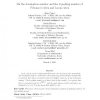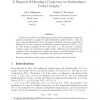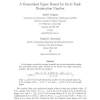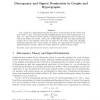153
Voted
CMA
2011
14 years 4 months ago
2011
Let Γn and Λn be the n-dimensional Fibonacci cube and Lucas cube, respectively. The domination number γ of Fibonacci cubes and Lucas cubes is studied. In particular it is prove...
92
Voted
DM
2008
15 years 8 days ago
2008
For two or more classes of points in Rd with d 1, the class cover catch digraphs (CCCDs) can be constructed using the relative positions of the points from one class with respect...
DM
2002
15 years 16 days ago
2002
Let ir(G) and (G) be the irredundance number and the domination number of a graph G, respectively. A graph G is called irredundance perfect if ir(H) = (H), for every induced subgr...
95
Voted
COMBINATORICS
2000
15 years 17 days ago
2000
Let (G) denote the domination number of a graph G and let G H denote the Cartesian product of graphs G and H. We prove that (G)(H) 2(G H) for all simple graphs G and H. 2000 Math...
109
Voted
DM
2007
15 years 21 days ago
2007
An upper bound for the domination number of the direct product of graphs is proved. It in particular implies that for any graphs G and H, γ(G × H) ≤ 3γ(G)γ(H). Graphs with a...
105
click to vote
AOR
2006
15 years 24 days ago
2006
The domination number, domn(A, n), of a heuristic A for the Asymmetric TSP is the maximum integer d = d(n) such that, for every instance I of the Asymmetric TSP on n cities, A pro...
97
Voted
DM
2008
15 years 24 days ago
2008
In this paper, we provide an upper bound for the k-tuple domination number that generalises known upper bounds for the double and triple domination numbers. We prove that for any ...
96
Voted
DM
2008
15 years 24 days ago
2008
The reinforcement number of a graph is the smallest number of edges that have to be added to a graph to reduce the domination number. We introduce the k-reinforcement number of a ...
DM
2010
15 years 24 days ago
2010
For a graph G, a signed domination function of G is a two-colouring of the vertices of G with colours +1 and
93
Voted
APPML
2008
15 years 26 days ago
2008
The following fundamental result for the domination number (G) of a graph G was proved by Alon and Spencer, Arnautov, Lov




